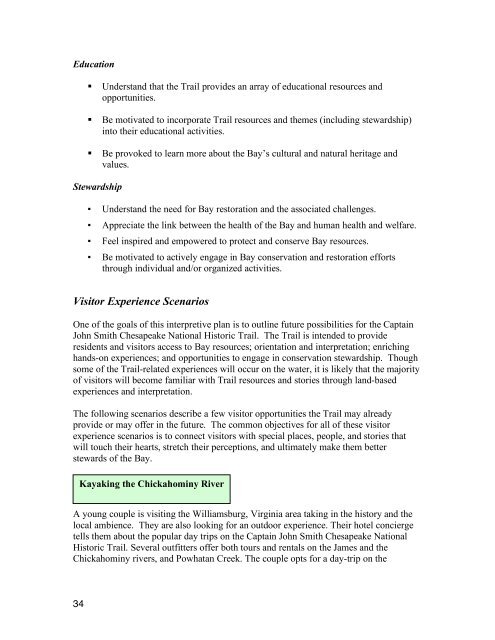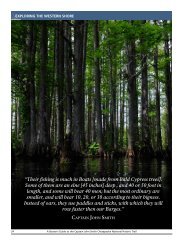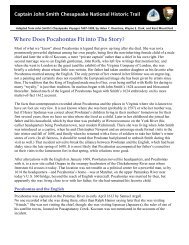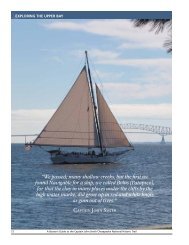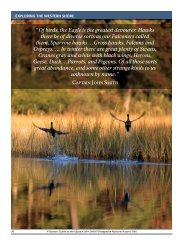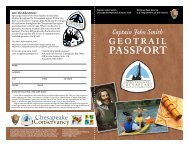Draft Interpretive Plan Join the adventure! - Captain John Smith ...
Draft Interpretive Plan Join the adventure! - Captain John Smith ...
Draft Interpretive Plan Join the adventure! - Captain John Smith ...
Create successful ePaper yourself
Turn your PDF publications into a flip-book with our unique Google optimized e-Paper software.
Education<br />
<br />
<br />
<br />
Understand that <strong>the</strong> Trail provides an array of educational resources and<br />
opportunities.<br />
Be motivated to incorporate Trail resources and <strong>the</strong>mes (including stewardship)<br />
into <strong>the</strong>ir educational activities.<br />
Be provoked to learn more about <strong>the</strong> Bay’s cultural and natural heritage and<br />
values.<br />
Stewardship<br />
▪<br />
▪<br />
▪<br />
▪<br />
Understand <strong>the</strong> need for Bay restoration and <strong>the</strong> associated challenges.<br />
Appreciate <strong>the</strong> link between <strong>the</strong> health of <strong>the</strong> Bay and human health and welfare.<br />
Feel inspired and empowered to protect and conserve Bay resources.<br />
Be motivated to actively engage in Bay conservation and restoration efforts<br />
through individual and/or organized activities.<br />
Visitor Experience Scenarios<br />
One of <strong>the</strong> goals of this interpretive plan is to outline future possibilities for <strong>the</strong> <strong>Captain</strong><br />
<strong>John</strong> <strong>Smith</strong> Chesapeake National Historic Trail. The Trail is intended to provide<br />
residents and visitors access to Bay resources; orientation and interpretation; enriching<br />
hands-on experiences; and opportunities to engage in conservation stewardship. Though<br />
some of <strong>the</strong> Trail-related experiences will occur on <strong>the</strong> water, it is likely that <strong>the</strong> majority<br />
of visitors will become familiar with Trail resources and stories through land-based<br />
experiences and interpretation.<br />
The following scenarios describe a few visitor opportunities <strong>the</strong> Trail may already<br />
provide or may offer in <strong>the</strong> future. The common objectives for all of <strong>the</strong>se visitor<br />
experience scenarios is to connect visitors with special places, people, and stories that<br />
will touch <strong>the</strong>ir hearts, stretch <strong>the</strong>ir perceptions, and ultimately make <strong>the</strong>m better<br />
stewards of <strong>the</strong> Bay.<br />
Kayaking <strong>the</strong> Chickahominy River<br />
A young couple is visiting <strong>the</strong> Williamsburg, Virginia area taking in <strong>the</strong> history and <strong>the</strong><br />
local ambience. They are also looking for an outdoor experience. Their hotel concierge<br />
tells <strong>the</strong>m about <strong>the</strong> popular day trips on <strong>the</strong> <strong>Captain</strong> <strong>John</strong> <strong>Smith</strong> Chesapeake National<br />
Historic Trail. Several outfitters offer both tours and rentals on <strong>the</strong> James and <strong>the</strong><br />
Chickahominy rivers, and Powhatan Creek. The couple opts for a day-trip on <strong>the</strong><br />
34


